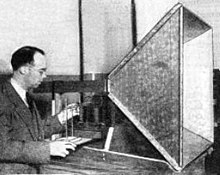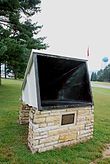Horn antenna


A horn antenna or microwave horn is an
One of the first horn antennas was constructed in 1897 by Bengali-Indian radio researcher
An advantage of horn antennas is that since they have no
Description

A horn antenna is used to transmit radio waves from a
How it works

A horn antenna serves the same function for
If a simple open-ended waveguide is used as an antenna, without the horn, the sudden end of the conductive walls causes an abrupt impedance change at the aperture, from the
To improve these poor characteristics, the ends of the waveguide are flared out to form a horn. The taper of the horn changes the impedance gradually along the horn's length.[12] This acts like an impedance matching transformer, allowing most of the wave energy to radiate out the end of the horn into space, with minimal reflection. The taper functions similarly to a tapered transmission line, or an optical medium with a smoothly varying refractive index. In addition, the wide aperture of the horn projects the waves in a narrow beam.
The horn shape that gives minimum reflected power is an exponential taper.[12] Exponential horns are used in special applications that require minimum signal loss, such as satellite antennas and radio telescopes. However conical and pyramidal horns are most widely used, because they have straight sides and are easier to design and fabricate.
Radiation pattern
The waves travel down a horn as spherical wavefronts, with their origin at the apex of the horn, a point called the phase center. The pattern of electric and magnetic fields at the aperture plane at the mouth of the horn, which determines the radiation pattern, is a scaled-up reproduction of the fields in the waveguide. Because the wavefronts are spherical, the phase increases smoothly from the edges of the aperture plane to the center, because of the difference in length of the center point and the edge points from the apex point. The difference in phase between the center point and the edges is called the phase error. This phase error, which increases with the flare angle, reduces the gain and increases the beamwidth, giving horns wider beamwidths than similar-sized plane-wave antennas such as parabolic dishes.
At the flare angle, the radiation of the beam lobe is down about 20 dB from its maximum value.[13]
As the size of a horn (expressed in wavelengths) is increased, the phase error increases, giving the horn a wider radiation pattern. Keeping the beamwidth narrow requires a longer horn (smaller flare angle) to keep the phase error constant. The increasing phase error limits the aperture size of practical horns to about 15 wavelengths; larger apertures would require impractically long horns.
Types


Below are the main types of horn antennas. Horns can have different flare angles as well as different expansion curves (elliptic, hyperbolic, etc.) in the E-field and H-field directions, making possible a wide variety of different beam profiles.
- Pyramidal horn (fig. a) – a horn antenna with the horn in the shape of a four-sided pyramid, with a rectangular cross section. They are a common type, used with rectangular waveguides, and radiate linearly polarized radio waves.[12]
- Sectoral horn – A pyramidal horn with only one pair of sides flared and the other pair parallel. It produces a fan-shaped beam, which is narrow in the plane of the flared sides, but wide in the plane of the narrow sides. These types are often used as feed horns for wide search radar antennas.
- Conical horn (fig. d) – A horn in the shape of a cone, with a circular cross section. They are used with cylindrical waveguides.
- Exponential horn (fig. e) – A horn with curved sides, in which the separation of the sides increases as an exponential function of length. Also called a scalar horn, they can have pyramidal or conical cross sections. Exponential horns have minimum internal reflections, and almost constant impedance and other characteristics over a wide frequency range. They are used in applications requiring high performance, such as feed horns for communication satellite antennas and radio telescopes.
- Corrugated horn – A horn with parallel slots or grooves, small compared with a wavelength, covering the inside surface of the horn, transverse to the axis. Corrugated horns have wider bandwidth and smaller sidelobes and cross-polarization, and are widely used as feed horns for satellite dishes and radio telescopes.
- Dual-mode conical horn – (The Potter horn [15]) This horn can be used to replace the corrugated horn for use at sub-mm wavelengths where the corrugated horn is lossy and difficult to fabricate.
- Diagonal horn – This simple dual-mode horn superficially looks like a pyramidal horn with a square output aperture. On closer inspection, however, the square output aperture is seen to be rotated 45° relative to the waveguide. These horns are typically machined into split blocks and used at sub-mm wavelengths.[16]
- Ridged horn – A pyramidal horn with ridges or fins attached to the inside of the horn, extending down the center of the sides. The fins lower the cutoff frequency, increasing the antenna's bandwidth.
- Septum horn – A horn which is divided into several subhorns by metal partitions (septums) inside, attached to opposite walls.
- Aperture-limited horn – a long narrow horn, long enough so the phase error is a negligible fraction of a wavelength,beamwidth for a given aperture size. The gain is not affected by the length but only limited by diffraction at the aperture.[13] Used as feed horns in radio telescopesand other high-resolution antennas.
- Open Boundary Quad-Ridged Horn Antenna – This horn antenna is a special type of horn antenna designed as a four-pronged structure with open boundaries. It covers width the frequency range and polarization is dual Linear.[17]
- Open Boundary Double-Ridged Horn Antenna – This kind of antenna is similar to an open boundary quad-ridged horn Antenna. It was designed to operate over a wide frequency range, low VSWR, and high gain.[10]
Optimum horn


For a given frequency and horn length, there is some flare angle that gives minimum reflection and maximum gain. The internal reflections in straight-sided horns come from the two locations along the wave path where the impedance changes abruptly; the mouth or aperture of the horn, and the throat where the sides begin to flare out. The amount of reflection at these two sites varies with the flare angle of the horn (the angle the sides make with the axis). In narrow horns with small flare angles most of the reflection occurs at the mouth of the horn. The
This discussion shows that there is some flare angle between 0° and 90° which gives maximum gain and minimum reflection.[18] This is called the optimum horn. Most practical horn antennas are designed as optimum horns. In a pyramidal horn, the dimensions that give an optimum horn are:[18][19]
For a conical horn, the dimensions that give an optimum horn are:[18]
where
- aE is the width of the aperture in the E-field direction
- aH is the width of the aperture in the H-field direction
- LE is the slant heightof the side in the E-field direction
- LH is the slant height of the side in the H-field direction
- d is the diameter of the cylindrical horn aperture
- L is the slant height of the cone from the apex
- λ is the wavelength
An optimum horn does not yield maximum gain for a given aperture size. That is achieved with a very long horn (an aperture limited horn). The optimum horn yields maximum gain for a given horn length. Tables showing dimensions for optimum horns for various frequencies are given in microwave handbooks.

Gain
Horns have very little loss, so the
For conical horns, the gain is:[18]
where
- A is the area of the aperture,
- d is the aperture diameter of a conical horn
- λ is the wavelength,
- eA is a dimensionless parameter between 0 and 1 called the aperture efficiency,
The aperture efficiency ranges from 0.4 to 0.8 in practical horn antennas. For optimum pyramidal horns, eA = 0.511.,[18] while for optimum conical horns eA = 0.522.[18] So an approximate figure of 0.5 is often used. The aperture efficiency increases with the length of the horn, and for aperture-limited horns is approximately unity.
Horn-reflector antenna
A type of antenna that combines a horn with a
See also
- Microwave Radiometer (Juno) (uses 1 horn antenna for Jupiter observations)
External links
- Horn Antennas Antenna-Theory.com
- "KS-15676 Horn-Reflector Antenna Description" (PDF). Bell System Practices, Issue 3, Section 402-421-100. AT&T Co. September 1975. on Albert LaFrance [long-lines.net] website
- U. S. patent no. 2416675 Horn antenna system, filed November 26, 1941, Alfred C. Beck, Harold T. Friis on Google Patents
References
- ^ a b c d e Bevelacqua, Peter Joseph (2009). "Horn antenna - Intro". Antenna-theory.com website. Retrieved 2010-11-11.
- ^ a b Poole, Ian. "Horn antenna". Radio-Electronics.com website. Adrio Communications Ltd. Retrieved 2010-11-11.
- ISBN 978-81-8431-176-1.
- ^ Rodriguez, Vincente (2010). "A brief history of horns". In Compliance Magazine. Same Page Publishing. Retrieved 2010-11-12.
- S2CID 9039614. Retrieved March 15, 2012.. Antentop. Vol. 2, no. 3. Belgorod, Russia. pp. 87–96.
{{cite book}}:|journal=ignored (help) reprinted in Grigorov, Igor (ed.). "The work of Jagadis Chandra Bose: 100 years of MM-wave research" - S2CID 51632525.
- S2CID 51635676. Retrieved October 28, 2015.
- ^ Barrow, Wilmer L, US patent 2467578 Electromagnetic horn, filed: December 10, 1946, granted: April 19, 1949
- ^ ISBN 0-85296-809-4.
- ^ ISBN 978-1-6654-4143-8.)
{{cite book}}:|website=ignored (help)CS1 maint: multiple names: authors list (link - ISBN 0-471-02590-9.
- ^ ISBN 978-81-8431-278-2.
- ^ ISBN 0-7803-3439-6.
- ^ ISBN 0-12-475952-1.
- ^ Potter, P. D. (1963). "A new horn antenna with suppressed sidelobes and equal beamwidths". Microwave J. 6: 71–78.
- .
- )
- ^ ISBN 1-58603-098-1.
- ^ a b Narayan 2007, p. 168
- ^ U. S. patent no. 2416675 Horn antenna system, filed November 26, 1941, Alfred C. Beck, Harold T. Friis on Google Patents
- ^
- ^ a b Meeks, 1976, p.13
- ^ ISBN 0-442-01357-4.
- ^ a b "KS-15676 Horn-Reflector Antenna Description" (PDF). Bell System Practices, Issue 3, Section 402-421-100. AT&T Co. September 1975. Retrieved 2011-12-20. on Albert LaFrance [long-lines.net] website
- ISBN 0-486-42876-1.






